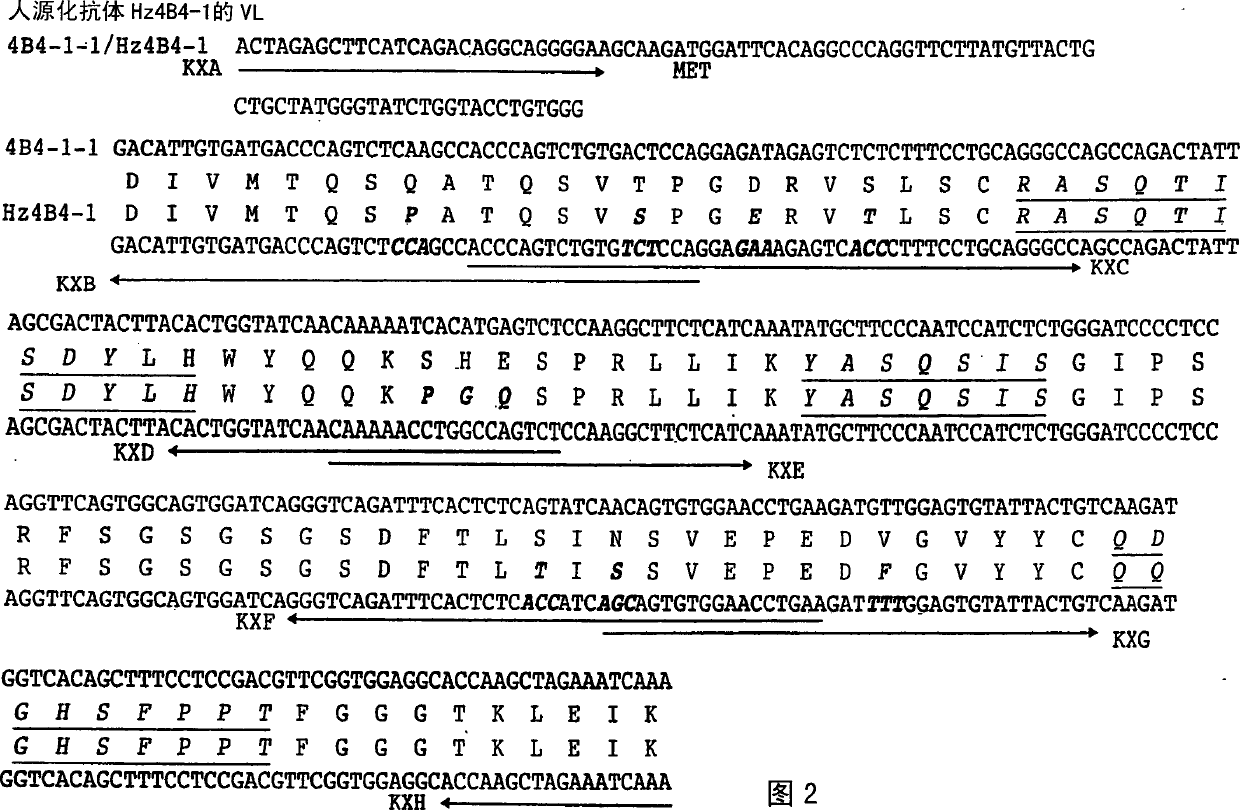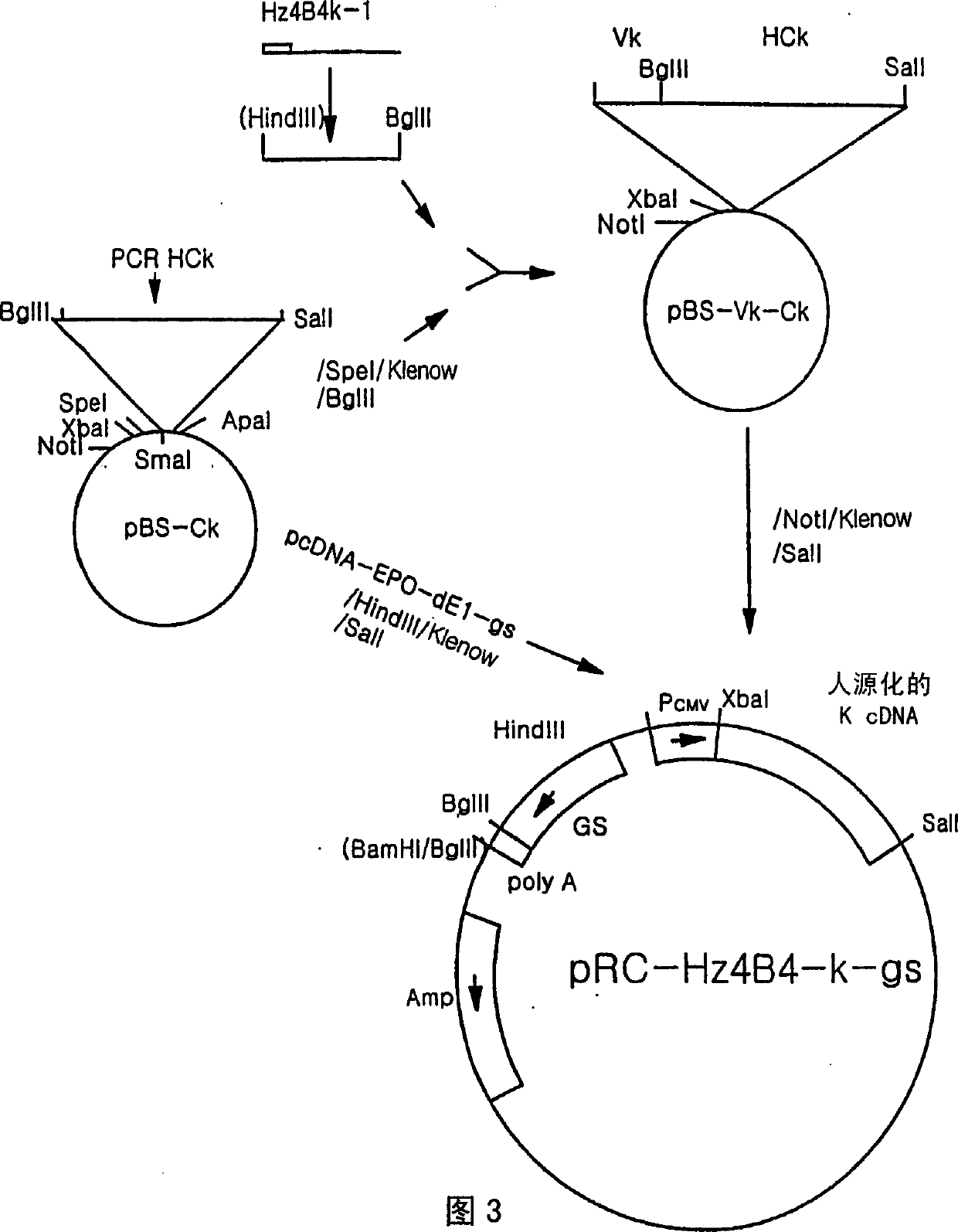Humanized antibody specific for human 4-1BB and pharmaceutical compsn comprising same
A technology of humanized antibodies and compositions, which is applied in the direction of drug combinations, antibody mimics/stents, and medical preparations containing active ingredients, etc., which can solve the problem of blocking antibody functions, reducing antibody half-life, and mouse antibody half-life. and other issues to achieve a high affinity effect
- Summary
- Abstract
- Description
- Claims
- Application Information
AI Technical Summary
Problems solved by technology
Method used
Image
Examples
Embodiment 1
[0037] Example 1: Design of humanized antibody Hz4B4-1
[0038] To construct a humanized antibody, the amino acid sequences of the light and heavy chain variable regions of the mouse monoclonal antibody 4B4-1-1 (Korean Laid-Open Application No. 96-37064) were compared with the human sequences in the gene database Compare. The human heavy chain variable region sequence M17750 (Dersimonian, H. et al., J. Immunol., 139, 2496 (1987)) which is very similar to the heavy chain sequence of the mouse 4B4-1-1 antibody was selected, and the sequence of the mouse 4B4-1-1 1-1 The antibody light chain is very similar to the human light chain variable region sequence X82934 (Esposito, G. et al., Arch. Vitrol., 142, 601 (1997)). To humanize the mouse monoclonal antibody 4B4-1-1, the CDR regions of the mouse antibody were transferred to a human antibody. At the same time, 10 key amino acid residues in the FR region of the humanized light chain and 11 key amino acid residues in the FR region ...
Embodiment 2
[0040] Example 2: Construction of gene encoding humanized antibody Hz4B4-1 and expression plasmid
[0041] Primers are prepared including the base sequence in the region where substitution is desired. These primers are: KXA (SEQ ID NO: 5), KXB (SEQ ID NO: 6), KXC (SEQ ID NO: 7), KXD (SEQ ID NO: 8), KXE (SEQ ID NO: 9), KXF ( SEQ ID NO: 10), KXG (SEQ ID NO: 11), KXH (SEQ ID NO: 12), AMH (SEQ ID NO: 13), BMH (SEQ ID NO: 14), CMH (SEQ ID NO: 15 ), DMH (SEQ ID NO: 16), EMH (SEQ ID NO: 17), FMH (SEQ ID NO: 18), GMH (SEQ ID NO 19), HMH (SEQ ID NO: 20).
[0042] Among the above primers, primers KXA (SEQ ID NO: 5) to KXH (SEQ ID NO: 12) were used to construct a gene encoding the humanized κ-light chain variable region. Primers AMH (SCQ ID NO: 13) to HMH (SEQ ID NO: 20) were used to construct the gene encoding the variable region of the humanized heavy chain. Figure 2 shows the humanized region in the humanized antibody Hz4B4-1 by the location of the primers, including genes encoding...
Embodiment 3
[0048] Example 3: Expression of humanized antibody Hz4B4-1 and screening of cells
[0049] 5% CO in GDMEM medium containing 10% permeable bovine serum (FBS) 2, CHO-K1 cells (ATCC CCL61) cultured at 37°C were inoculated into a petri dish with a diameter of 6 cm to obtain 5×10 5 cell. GDMEM medium containing DMEM (Gibco), 4.5g / L glucose, 15mg / L phenol red, 1mM sodium pyruvate, 1.75g / L sodium bicarbonate, 500μm asparagine, 30μm adenosine, 30μm guanosine, 30μm cytidine , 30 μM uridine, 10 μM thymidine and non-essential amino acids (GIBCO). 2.5 μg of the pRc-Hz4B4-k-gs plasmid prepared from Example 2 and 2.5 μg of the pCI-Hz4B4-H plasmid were combined, and 0.3ml OPTI-MEM I TM (GIBCO) diluted with 0.3ml of OPTI-MEM I TM Dilute 15 μl of Lipofectamine TM (GIBCO), then mixed and left for 15 minutes.
[0050] Pre-cultured cells with OPTI-MEM I TM Wash 3 times. Then the plasmid-Lipofectamine prepared in the previous step TM The mixture was added evenly to the cells. Cells in 5%...
PUM
 Login to View More
Login to View More Abstract
Description
Claims
Application Information
 Login to View More
Login to View More - R&D
- Intellectual Property
- Life Sciences
- Materials
- Tech Scout
- Unparalleled Data Quality
- Higher Quality Content
- 60% Fewer Hallucinations
Browse by: Latest US Patents, China's latest patents, Technical Efficacy Thesaurus, Application Domain, Technology Topic, Popular Technical Reports.
© 2025 PatSnap. All rights reserved.Legal|Privacy policy|Modern Slavery Act Transparency Statement|Sitemap|About US| Contact US: help@patsnap.com



